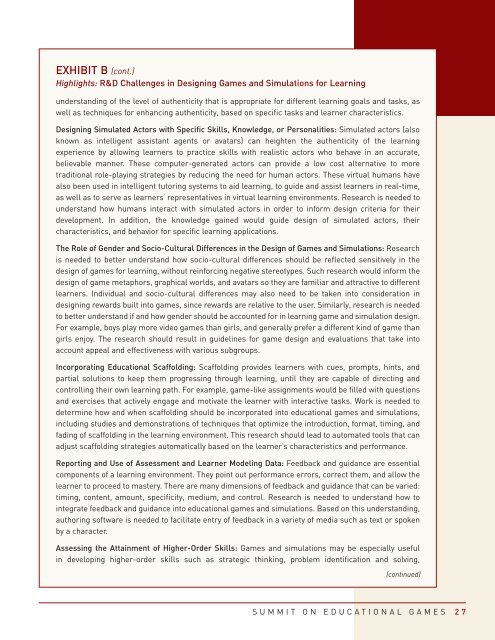Summit on Educational Games - Federation of American Scientists
Summit on Educational Games - Federation of American Scientists
Summit on Educational Games - Federation of American Scientists
You also want an ePaper? Increase the reach of your titles
YUMPU automatically turns print PDFs into web optimized ePapers that Google loves.
EXHIBIT B (c<strong>on</strong>t.)<br />
Highlights: R&D Challenges in Designing <strong>Games</strong> and Simulati<strong>on</strong>s for Learning<br />
understanding <strong>of</strong> the level <strong>of</strong> authenticity that is appropriate for different learning goals and tasks, as<br />
well as techniques for enhancing authenticity, based <strong>on</strong> specific tasks and learner characteristics.<br />
Designing Simulated Actors with Specific Skills, Knowledge, or Pers<strong>on</strong>alities: Simulated actors (also<br />
known as intelligent assistant agents or avatars) can heighten the authenticity <strong>of</strong> the learning<br />
experience by allowing learners to practice skills with realistic actors who behave in an accurate,<br />
believable manner. These computer-generated actors can provide a low cost alternative to more<br />
traditi<strong>on</strong>al role-playing strategies by reducing the need for human actors. These virtual humans have<br />
also been used in intelligent tutoring systems to aid learning, to guide and assist learners in real-time,<br />
as well as to serve as learners’ representatives in virtual learning envir<strong>on</strong>ments. Research is needed to<br />
understand how humans interact with simulated actors in order to inform design criteria for their<br />
development. In additi<strong>on</strong>, the knowledge gained would guide design <strong>of</strong> simulated actors, their<br />
characteristics, and behavior for specific learning applicati<strong>on</strong>s.<br />
The Role <strong>of</strong> Gender and Socio-Cultural Differences in the Design <strong>of</strong> <strong>Games</strong> and Simulati<strong>on</strong>s: Research<br />
is needed to better understand how socio-cultural differences should be reflected sensitively in the<br />
design <strong>of</strong> games for learning, without reinforcing negative stereotypes. Such research would inform the<br />
design <strong>of</strong> game metaphors, graphical worlds, and avatars so they are familiar and attractive to different<br />
learners. Individual and socio-cultural differences may also need to be taken into c<strong>on</strong>siderati<strong>on</strong> in<br />
designing rewards built into games, since rewards are relative to the user. Similarly, research is needed<br />
to better understand if and how gender should be accounted for in learning game and simulati<strong>on</strong> design.<br />
For example, boys play more video games than girls, and generally prefer a different kind <strong>of</strong> game than<br />
girls enjoy. The research should result in guidelines for game design and evaluati<strong>on</strong>s that take into<br />
account appeal and effectiveness with various subgroups.<br />
Incorporating Educati<strong>on</strong>al Scaffolding: Scaffolding provides learners with cues, prompts, hints, and<br />
partial soluti<strong>on</strong>s to keep them progressing through learning, until they are capable <strong>of</strong> directing and<br />
c<strong>on</strong>trolling their own learning path. For example, game-like assignments would be filled with questi<strong>on</strong>s<br />
and exercises that actively engage and motivate the learner with interactive tasks. Work is needed to<br />
determine how and when scaffolding should be incorporated into educati<strong>on</strong>al games and simulati<strong>on</strong>s,<br />
including studies and dem<strong>on</strong>strati<strong>on</strong>s <strong>of</strong> techniques that optimize the introducti<strong>on</strong>, format, timing, and<br />
fading <strong>of</strong> scaffolding in the learning envir<strong>on</strong>ment. This research should lead to automated tools that can<br />
adjust scaffolding strategies automatically based <strong>on</strong> the learner’s characteristics and performance.<br />
Reporting and Use <strong>of</strong> Assessment and Learner Modeling Data: Feedback and guidance are essential<br />
comp<strong>on</strong>ents <strong>of</strong> a learning envir<strong>on</strong>ment. They point out performance errors, correct them, and allow the<br />
learner to proceed to mastery. There are many dimensi<strong>on</strong>s <strong>of</strong> feedback and guidance that can be varied:<br />
timing, c<strong>on</strong>tent, amount, specificity, medium, and c<strong>on</strong>trol. Research is needed to understand how to<br />
integrate feedback and guidance into educati<strong>on</strong>al games and simulati<strong>on</strong>s. Based <strong>on</strong> this understanding,<br />
authoring s<strong>of</strong>tware is needed to facilitate entry <strong>of</strong> feedback in a variety <strong>of</strong> media such as text or spoken<br />
by a character.<br />
Assessing the Attainment <strong>of</strong> Higher-Order Skills: <strong>Games</strong> and simulati<strong>on</strong>s may be especially useful<br />
in developing higher-order skills such as strategic thinking, problem identificati<strong>on</strong> and solving,<br />
(c<strong>on</strong>tinued)<br />
SUMMIT ON EDUCATIONAL GAMES 27
















